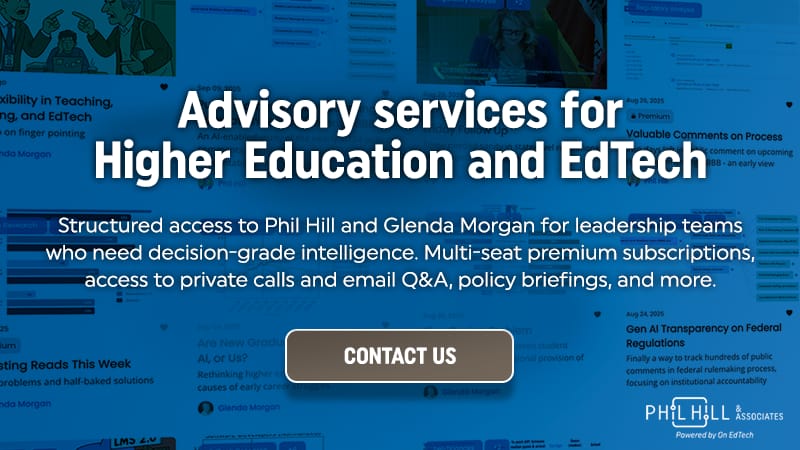Anthology's Chapter 11 Bankruptcy by the Numbers
Debt interest payments were 41% of total revenue, and other insights from the court filings

Was this forwarded to you by a friend? Sign up, and get your own copy of the news that matters sent to your inbox every week. Sign up for the On EdTech newsletter. Interested in additional analysis? Upgrade to the On EdTech+ newsletter.
Following on to yesterday’s post about Anthology (Blackboard) declaring Chapter 11 bankruptcy, I finally got around to digesting additional court filings that describe the company’s financial situation. Some of the numbers are remarkable and should clarify the situation.
All of the below is based on the current bankruptcy plans for Anthology, but note that there is a small but non-zero chance of alternative bids coming in in the next six weeks. As a reminder of the current plan: the company will remain and focus on the core LMS and teaching & learning segment; Ellucian buys the SIS & other ERP segment; Encoura buys the Lifecycle Engagement (including the CRM) and the Student Success segments.
Back to the Blackboard Brand
Before we get to hard numbers, can we first appreciate some upcoming brand clarity? Anthology bought Blackboard in 2021, but the latter had higher revenue and greater brand recognition. This led to awkward usages of Anthology (Blackboard), Anthology / Blackboard, Anthology the owner of Blackboard, etc.
Ellucian and Encoura are purchasing the Anthology and CampusNexus brands, and the residual company will only have access to these brands for a transitional period of 12 months. Given that the remaining business will be the teaching & learning core defined mostly by Blackboard, this likely means the new (old?) company brand will simply be Blackboard. Hallelujah.
Total Revenue
For FY25 (that ended June 30th), Anthology’s total revenue was $450 million. Of this, the Blackboard T&L segment accounted for the majority, at $240 million.
Two years earlier (FY23), Anthology’s total revenue was approximately $530 million, representing roughly an 8% decline per year.
To put this in perspective with industry competitors:
Instructure’s estimated trailing twelve month (TTM) revenue as of a year ago was $634 million.
D2L’s TTM revenue is $215 million.
Ellucian’s estimated 2025 revenue is $1.1 billion.
Total EBITDA
Anthology’s Earnings Before Interest, Taxes, Depreciation, and Amortization (EBITDA) for FY25 was $4 million, an 88% decline from $33 million in FY23 (two year change. Note that this is before making interest payments.
Total Debt
Anthology holds roughly $1.7 billion in funded debt. Of that, $1.2B is the core secured debt under the 1L agreement for which the superpriority credit agreement lenders (Nexus and Oaktree in particular) are the controlling class.
Again to put this in perspective:
Instructure’s total debt was reported by S&P’s as $1.7 billion (although $1.3 billion of that was reclassified as equity).
D2L’s total long-term debt is reported as $11.6 million (no, that’s not a typo).
Ellucian’s total debt was reported by Moody’s as $3.2 billion.
Debt Payments
Anthology’s “had approximately $185 million in annual cash interest payments on its secured debt obligations” as of the end of 2024 when it first skipped payments.
That is fully 41% of total revenue. There was no possible way for Anthology to meet debt obligations without selling or declaring bankruptcy (and they are planning to do both).
Stalking Horse Bids
The initial stalking horse bids (binding agreements from Ellucian and Encoura) that could be increased or replaced with better offers) are part of the process.
Ellucian’s bid for the SIS & ERP portion of the business (called Enterprise Operations) is $70 million. This includes the transfer of employees, but it is not clear how many.
Encoura’s bid for the CRM (called Lifecycle Engagement) & Student Success portions of the business is $50 million. This includes an agreement for Encoura to offer employment to at least 70% of those employees.
The Offer
The controlling lenders have offered $50 million in new money term loans. In combination with cash on hand, this short-term credit facility will fund payroll, vendor payments, and other day-to-day operations during the Chapter 11 process. It ensures continuity of service for university clients while the company restructures and sells business units.
Coming out of the process, the new Blackboard will have $0 in long-term debt on its balance sheet.
As for the prospects of the new post-bankruptcy Blackboard, I will further address that at On EdTech+.
The main On EdTech newsletter is free to share in part or in whole. All we ask is attribution.
Thanks for being a subscriber.
